2001 CHRYSLER VOYAGER diagram
[x] Cancel search: diagramPage 4227 of 4284
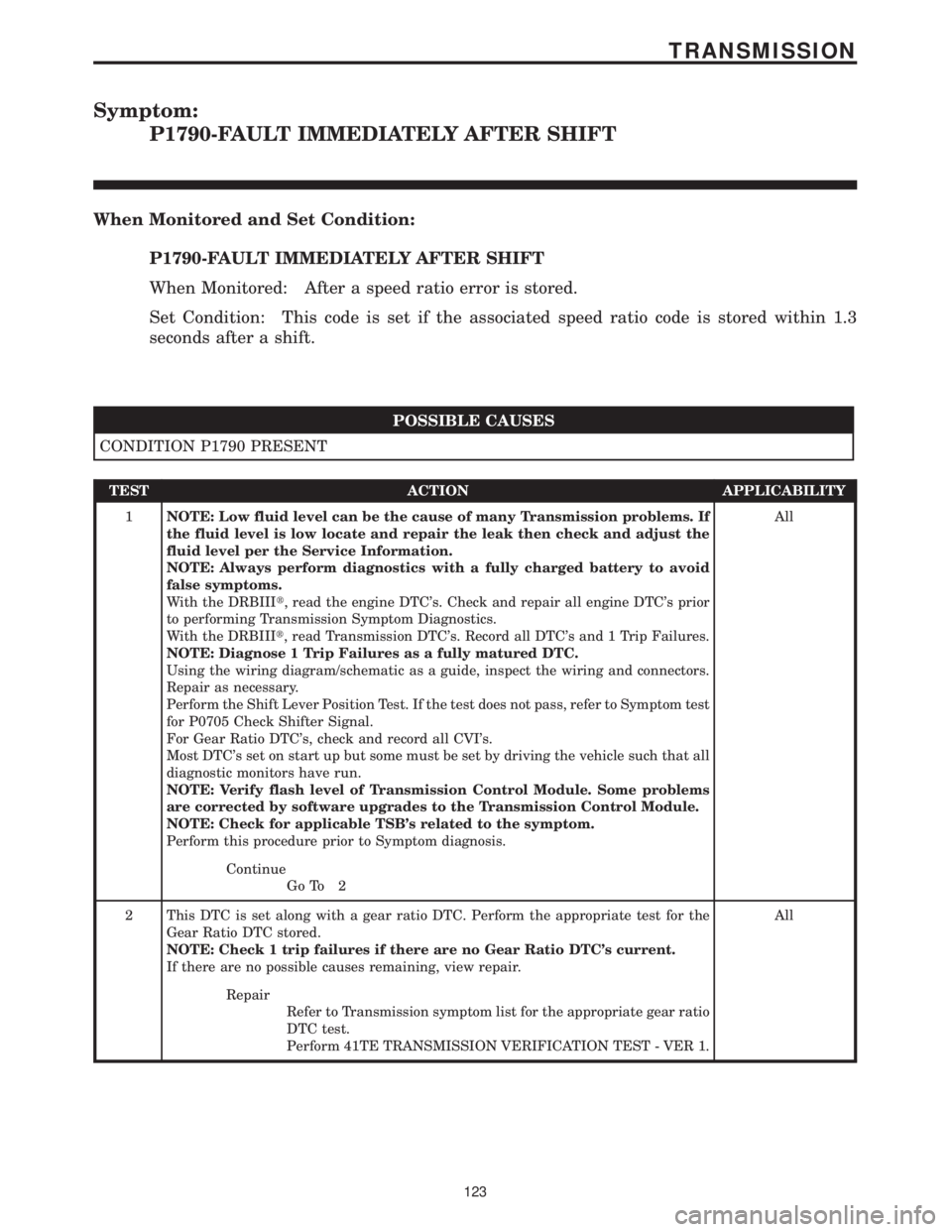
Symptom:
P1790-FAULT IMMEDIATELY AFTER SHIFT
When Monitored and Set Condition:
P1790-FAULT IMMEDIATELY AFTER SHIFT
When Monitored: After a speed ratio error is stored.
Set Condition: This code is set if the associated speed ratio code is stored within 1.3
seconds after a shift.
POSSIBLE CAUSES
CONDITION P1790 PRESENT
TEST ACTION APPLICABILITY
1NOTE: Low fluid level can be the cause of many Transmission problems. If
the fluid level is low locate and repair the leak then check and adjust the
fluid level per the Service Information.
NOTE: Always perform diagnostics with a fully charged battery to avoid
false symptoms.
With the DRBIIIt, read the engine DTC's. Check and repair all engine DTC's prior
to performing Transmission Symptom Diagnostics.
With the DRBIIIt, read Transmission DTC's. Record all DTC's and 1 Trip Failures.
NOTE: Diagnose 1 Trip Failures as a fully matured DTC.
Using the wiring diagram/schematic as a guide, inspect the wiring and connectors.
Repair as necessary.
Perform the Shift Lever Position Test. If the test does not pass, refer to Symptom test
for P0705 Check Shifter Signal.
For Gear Ratio DTC's, check and record all CVI's.
Most DTC's set on start up but some must be set by driving the vehicle such that all
diagnostic monitors have run.
NOTE: Verify flash level of Transmission Control Module. Some problems
are corrected by software upgrades to the Transmission Control Module.
NOTE: Check for applicable TSB's related to the symptom.
Perform this procedure prior to Symptom diagnosis.All
Continue
Go To 2
2 This DTC is set along with a gear ratio DTC. Perform the appropriate test for the
Gear Ratio DTC stored.
NOTE: Check 1 trip failures if there are no Gear Ratio DTC's current.
If there are no possible causes remaining, view repair.All
Repair
Refer to Transmission symptom list for the appropriate gear ratio
DTC test.
Perform 41TE TRANSMISSION VERIFICATION TEST - VER 1.
123
TRANSMISSION
Page 4228 of 4284
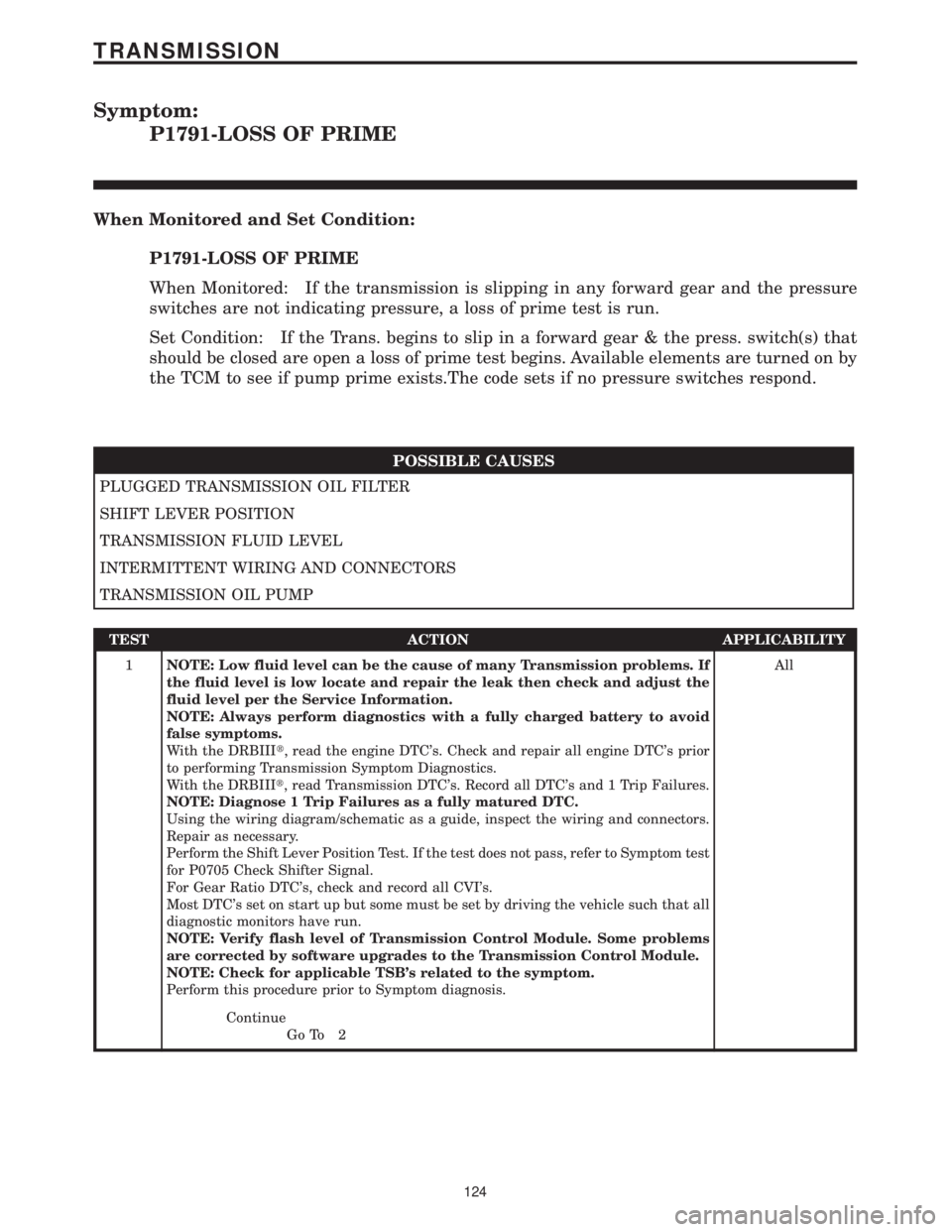
Symptom:
P1791-LOSS OF PRIME
When Monitored and Set Condition:
P1791-LOSS OF PRIME
When Monitored: If the transmission is slipping in any forward gear and the pressure
switches are not indicating pressure, a loss of prime test is run.
Set Condition: If the Trans. begins to slip in a forward gear & the press. switch(s) that
should be closed are open a loss of prime test begins. Available elements are turned on by
the TCM to see if pump prime exists.The code sets if no pressure switches respond.
POSSIBLE CAUSES
PLUGGED TRANSMISSION OIL FILTER
SHIFT LEVER POSITION
TRANSMISSION FLUID LEVEL
INTERMITTENT WIRING AND CONNECTORS
TRANSMISSION OIL PUMP
TEST ACTION APPLICABILITY
1NOTE: Low fluid level can be the cause of many Transmission problems. If
the fluid level is low locate and repair the leak then check and adjust the
fluid level per the Service Information.
NOTE: Always perform diagnostics with a fully charged battery to avoid
false symptoms.
With the DRBIIIt, read the engine DTC's. Check and repair all engine DTC's prior
to performing Transmission Symptom Diagnostics.
With the DRBIIIt, read Transmission DTC's. Record all DTC's and 1 Trip Failures.
NOTE: Diagnose 1 Trip Failures as a fully matured DTC.
Using the wiring diagram/schematic as a guide, inspect the wiring and connectors.
Repair as necessary.
Perform the Shift Lever Position Test. If the test does not pass, refer to Symptom test
for P0705 Check Shifter Signal.
For Gear Ratio DTC's, check and record all CVI's.
Most DTC's set on start up but some must be set by driving the vehicle such that all
diagnostic monitors have run.
NOTE: Verify flash level of Transmission Control Module. Some problems
are corrected by software upgrades to the Transmission Control Module.
NOTE: Check for applicable TSB's related to the symptom.
Perform this procedure prior to Symptom diagnosis.All
Continue
Go To 2
124
TRANSMISSION
Page 4231 of 4284
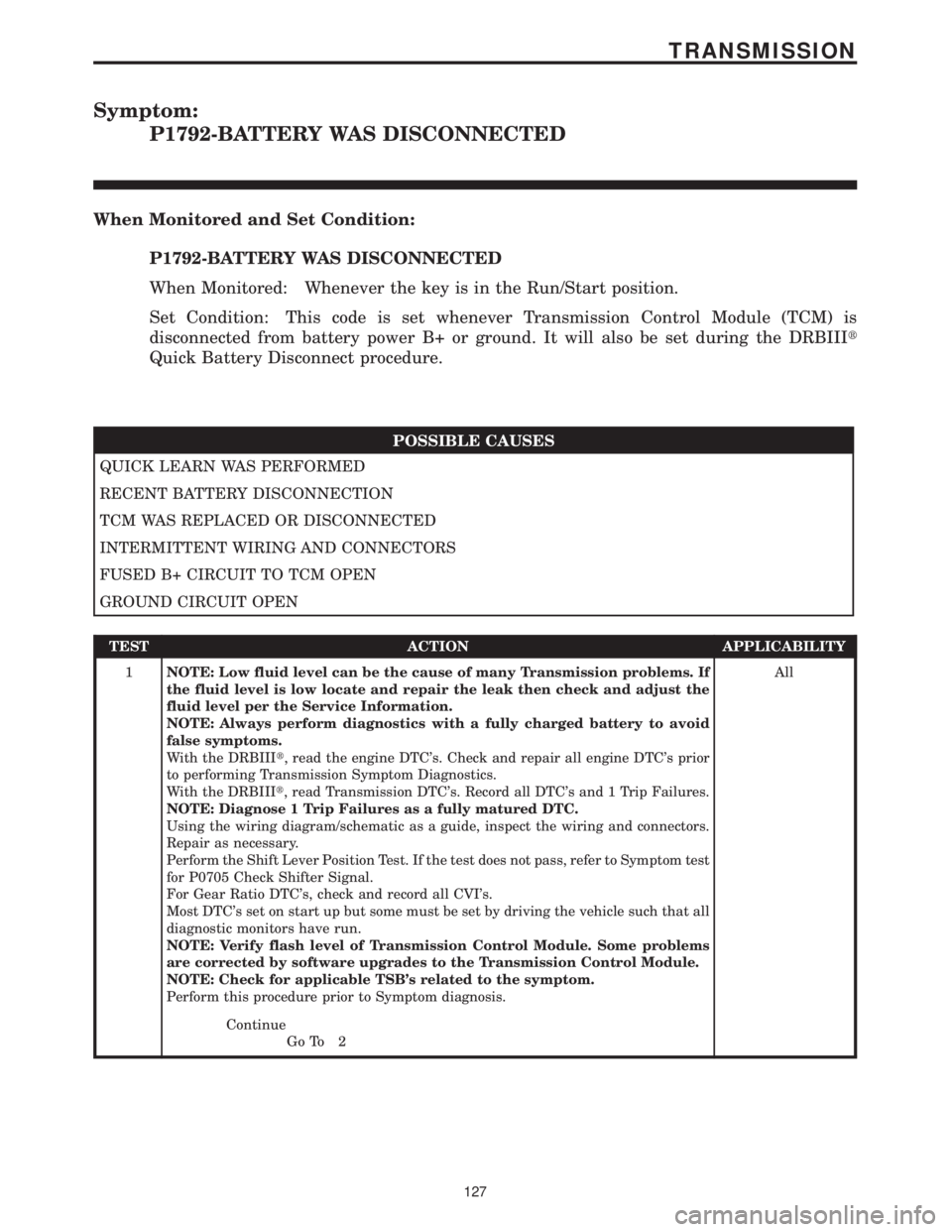
Symptom:
P1792-BATTERY WAS DISCONNECTED
When Monitored and Set Condition:
P1792-BATTERY WAS DISCONNECTED
When Monitored: Whenever the key is in the Run/Start position.
Set Condition: This code is set whenever Transmission Control Module (TCM) is
disconnected from battery power B+ or ground. It will also be set during the DRBIIIt
Quick Battery Disconnect procedure.
POSSIBLE CAUSES
QUICK LEARN WAS PERFORMED
RECENT BATTERY DISCONNECTION
TCM WAS REPLACED OR DISCONNECTED
INTERMITTENT WIRING AND CONNECTORS
FUSED B+ CIRCUIT TO TCM OPEN
GROUND CIRCUIT OPEN
TEST ACTION APPLICABILITY
1NOTE: Low fluid level can be the cause of many Transmission problems. If
the fluid level is low locate and repair the leak then check and adjust the
fluid level per the Service Information.
NOTE: Always perform diagnostics with a fully charged battery to avoid
false symptoms.
With the DRBIIIt, read the engine DTC's. Check and repair all engine DTC's prior
to performing Transmission Symptom Diagnostics.
With the DRBIIIt, read Transmission DTC's. Record all DTC's and 1 Trip Failures.
NOTE: Diagnose 1 Trip Failures as a fully matured DTC.
Using the wiring diagram/schematic as a guide, inspect the wiring and connectors.
Repair as necessary.
Perform the Shift Lever Position Test. If the test does not pass, refer to Symptom test
for P0705 Check Shifter Signal.
For Gear Ratio DTC's, check and record all CVI's.
Most DTC's set on start up but some must be set by driving the vehicle such that all
diagnostic monitors have run.
NOTE: Verify flash level of Transmission Control Module. Some problems
are corrected by software upgrades to the Transmission Control Module.
NOTE: Check for applicable TSB's related to the symptom.
Perform this procedure prior to Symptom diagnosis.All
Continue
Go To 2
127
TRANSMISSION
Page 4234 of 4284

Symptom:
P1793-TRD LINK COMMUNICATION ERROR
When Monitored and Set Condition:
P1793-TRD LINK COMMUNICATION ERROR
When Monitored: The transmission controller pulses the 12 volt TRD signal from the
PCM to ground, during torque managed shifts with the throttle angle above 54 degrees.
The TRD system is also tested whenever the vehicle is stopped and the engine speed is at
idle.
Set Condition: This code is set when the Transmission Control Module (TCM) sends two
subsequent torque reduction messages to the Powertrain Control Module (PCM) via the
TRD link circuit and does not receive a confirmation from the PCM over the communica-
tion bus.
POSSIBLE CAUSES
RELATED DTC'S PRESENT
INTERMITTENT WIRING AND CONNECTORS
TORQUE MANAGEMENT REQUEST SENSE CIRCUIT OPEN
TORQUE MANAGEMENT REQUEST SENSE SHORT TO GROUND
TORQUE MANAGEMENT REQUEST SENSE CIRCUIT SHORT TO VOLTAGE
PCM - TRD LINK
TCM - TRD LINK
TEST ACTION APPLICABILITY
1NOTE: Low fluid level can be the cause of many Transmission problems. If
the fluid level is low locate and repair the leak then check and adjust the
fluid level per the Service Information.
NOTE: Always perform diagnostics with a fully charged battery to avoid
false symptoms.
With the DRBIIIt, read the engine DTC's. Check and repair all engine DTC's prior
to performing Transmission Symptom Diagnostics.
With the DRBIIIt, read Transmission DTC's. Record all DTC's and 1 Trip Failures.
NOTE: Diagnose 1 Trip Failures as a fully matured DTC.
Using the wiring diagram/schematic as a guide, inspect the wiring and connectors.
Repair as necessary.
Perform the Shift Lever Position Test. If the test does not pass, refer to Symptom test
for P0705 Check Shifter Signal.
For Gear Ratio DTC's, check and record all CVI's.
Most DTC's set on start up but some must be set by driving the vehicle such that all
diagnostic monitors have run.
NOTE: Verify flash level of Transmission Control Module. Some problems
are corrected by software upgrades to the Transmission Control Module.
NOTE: Check for applicable TSB's related to the symptom.
Perform this procedure prior to Symptom diagnosis.All
Continue
Go To 2
130
TRANSMISSION
Page 4237 of 4284
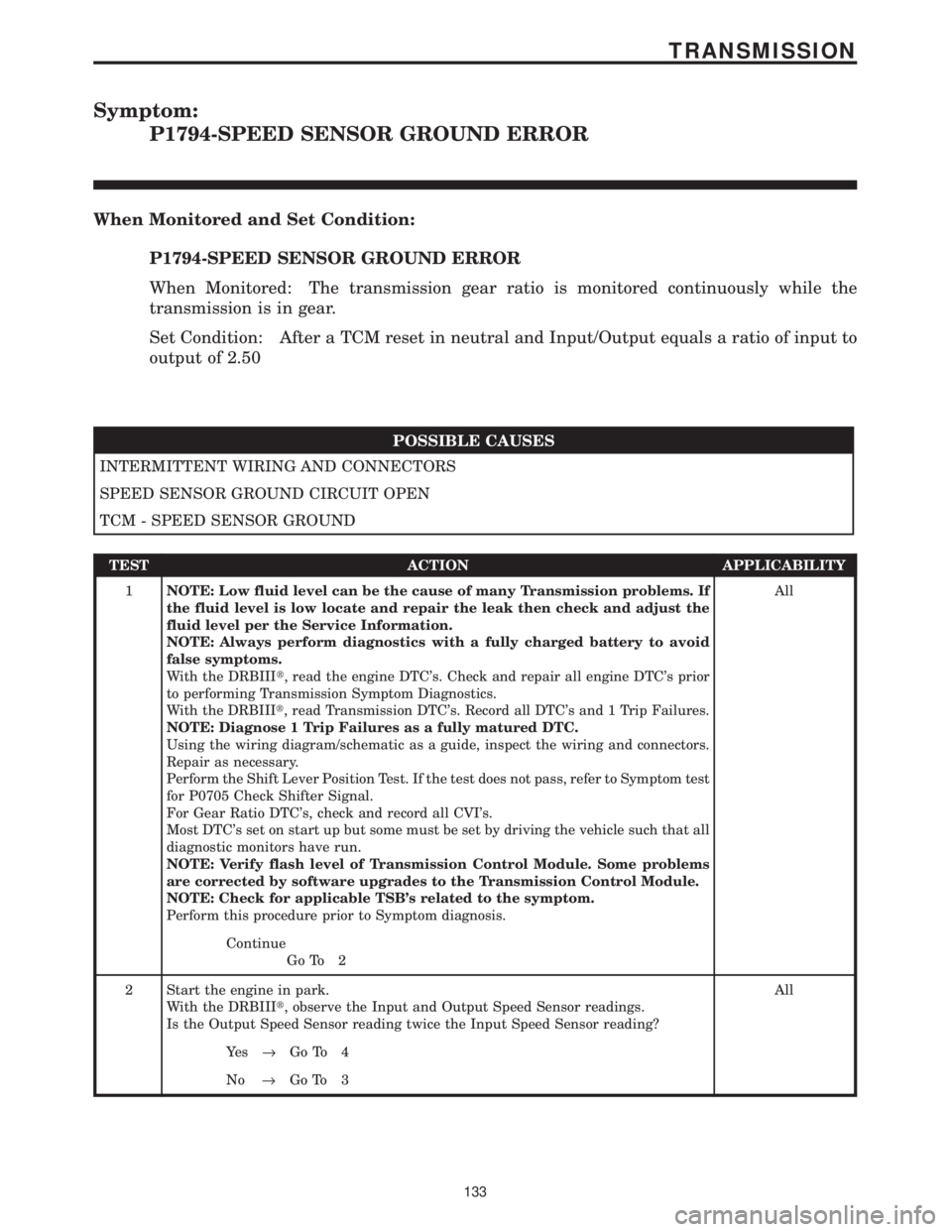
Symptom:
P1794-SPEED SENSOR GROUND ERROR
When Monitored and Set Condition:
P1794-SPEED SENSOR GROUND ERROR
When Monitored: The transmission gear ratio is monitored continuously while the
transmission is in gear.
Set Condition: After a TCM reset in neutral and Input/Output equals a ratio of input to
output of 2.50
POSSIBLE CAUSES
INTERMITTENT WIRING AND CONNECTORS
SPEED SENSOR GROUND CIRCUIT OPEN
TCM - SPEED SENSOR GROUND
TEST ACTION APPLICABILITY
1NOTE: Low fluid level can be the cause of many Transmission problems. If
the fluid level is low locate and repair the leak then check and adjust the
fluid level per the Service Information.
NOTE: Always perform diagnostics with a fully charged battery to avoid
false symptoms.
With the DRBIIIt, read the engine DTC's. Check and repair all engine DTC's prior
to performing Transmission Symptom Diagnostics.
With the DRBIIIt, read Transmission DTC's. Record all DTC's and 1 Trip Failures.
NOTE: Diagnose 1 Trip Failures as a fully matured DTC.
Using the wiring diagram/schematic as a guide, inspect the wiring and connectors.
Repair as necessary.
Perform the Shift Lever Position Test. If the test does not pass, refer to Symptom test
for P0705 Check Shifter Signal.
For Gear Ratio DTC's, check and record all CVI's.
Most DTC's set on start up but some must be set by driving the vehicle such that all
diagnostic monitors have run.
NOTE: Verify flash level of Transmission Control Module. Some problems
are corrected by software upgrades to the Transmission Control Module.
NOTE: Check for applicable TSB's related to the symptom.
Perform this procedure prior to Symptom diagnosis.All
Continue
Go To 2
2 Start the engine in park.
With the DRBIIIt, observe the Input and Output Speed Sensor readings.
Is the Output Speed Sensor reading twice the Input Speed Sensor reading?All
Ye s®Go To 4
No®Go To 3
133
TRANSMISSION
Page 4242 of 4284
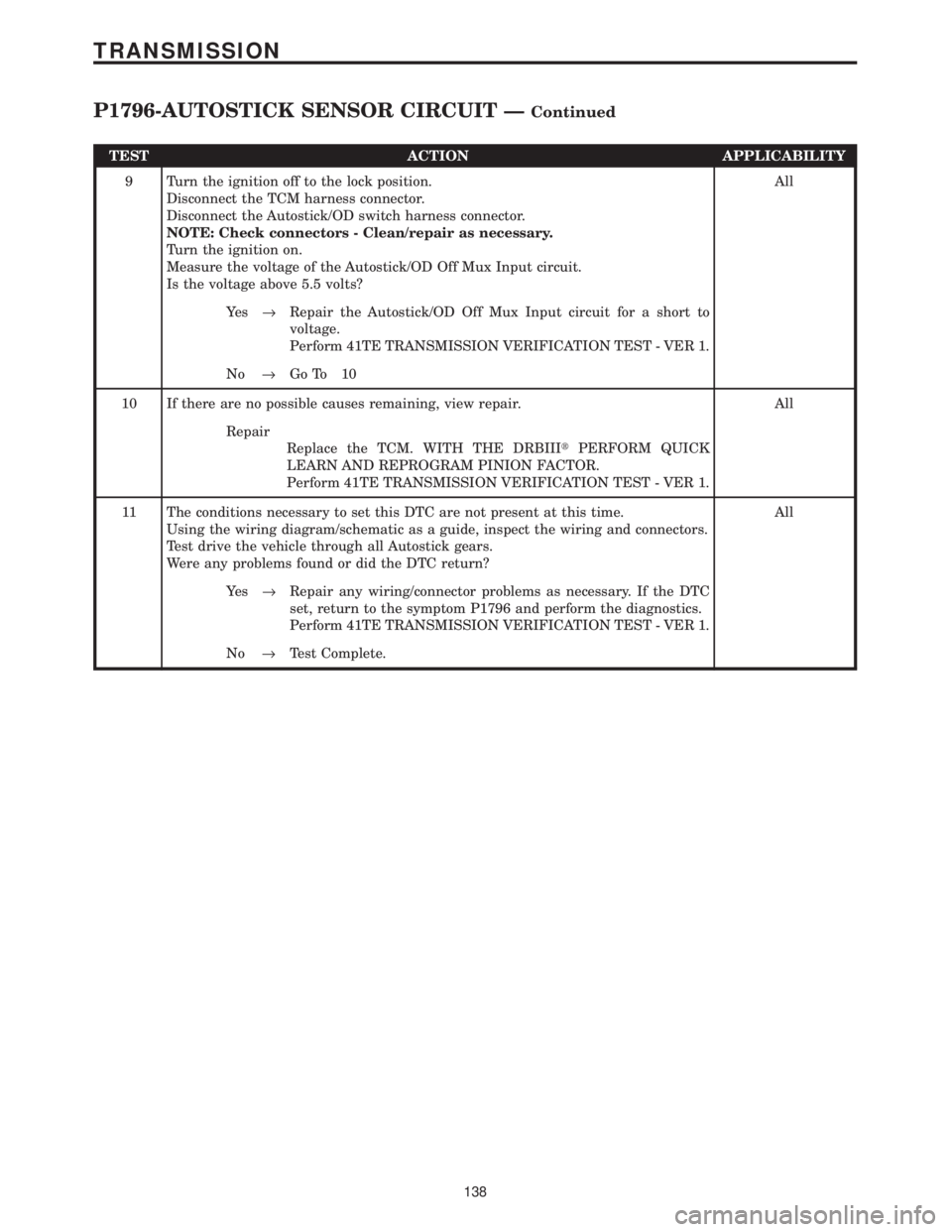
TEST ACTION APPLICABILITY
9 Turn the ignition off to the lock position.
Disconnect the TCM harness connector.
Disconnect the Autostick/OD switch harness connector.
NOTE: Check connectors - Clean/repair as necessary.
Turn the ignition on.
Measure the voltage of the Autostick/OD Off Mux Input circuit.
Is the voltage above 5.5 volts?All
Ye s®Repair the Autostick/OD Off Mux Input circuit for a short to
voltage.
Perform 41TE TRANSMISSION VERIFICATION TEST - VER 1.
No®Go To 10
10 If there are no possible causes remaining, view repair. All
Repair
Replace the TCM. WITH THE DRBIIItPERFORM QUICK
LEARN AND REPROGRAM PINION FACTOR.
Perform 41TE TRANSMISSION VERIFICATION TEST - VER 1.
11 The conditions necessary to set this DTC are not present at this time.
Using the wiring diagram/schematic as a guide, inspect the wiring and connectors.
Test drive the vehicle through all Autostick gears.
Were any problems found or did the DTC return?All
Ye s®Repair any wiring/connector problems as necessary. If the DTC
set, return to the symptom P1796 and perform the diagnostics.
Perform 41TE TRANSMISSION VERIFICATION TEST - VER 1.
No®Test Complete.
138
TRANSMISSION
P1796-AUTOSTICK SENSOR CIRCUIT ÐContinued
Page 4243 of 4284
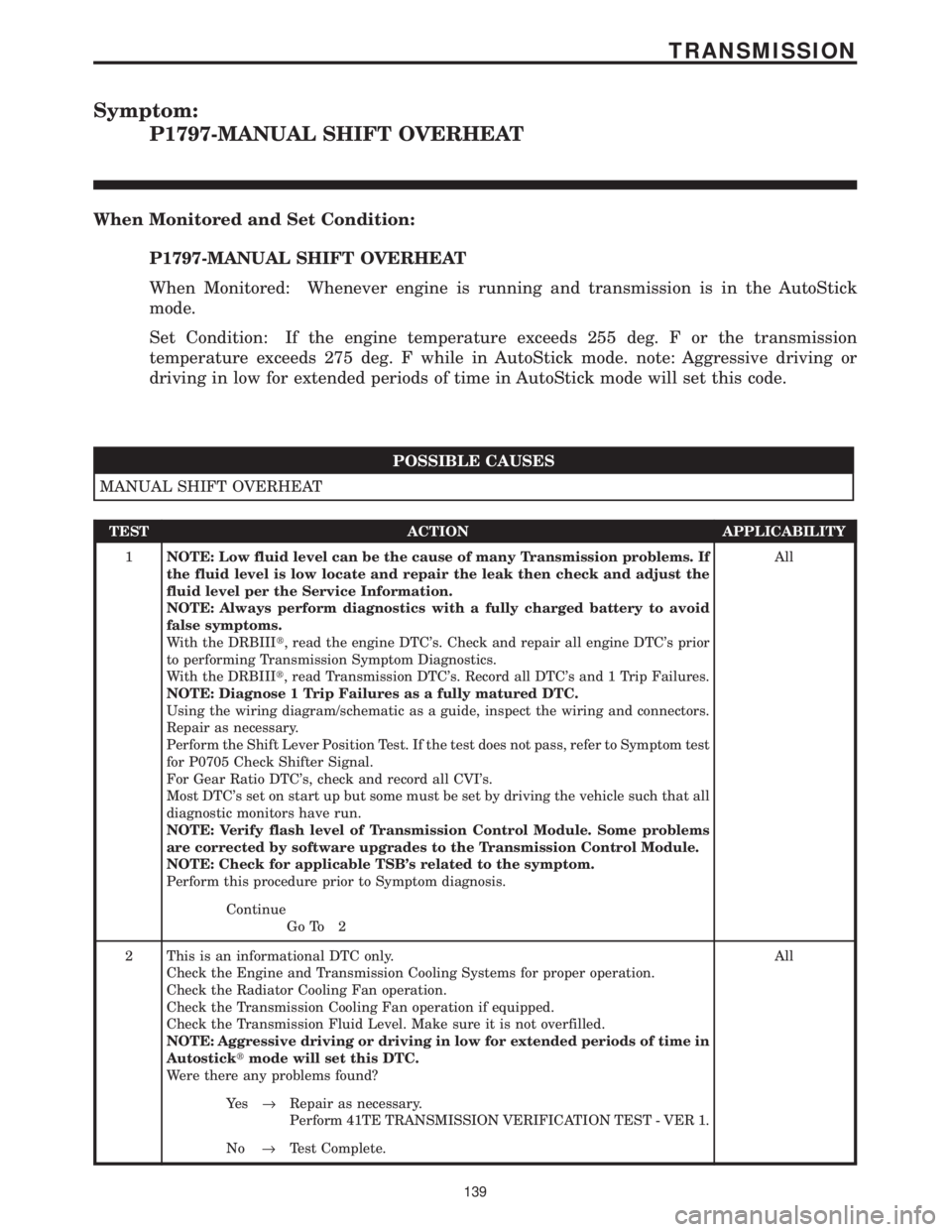
Symptom:
P1797-MANUAL SHIFT OVERHEAT
When Monitored and Set Condition:
P1797-MANUAL SHIFT OVERHEAT
When Monitored: Whenever engine is running and transmission is in the AutoStick
mode.
Set Condition: If the engine temperature exceeds 255 deg. F or the transmission
temperature exceeds 275 deg. F while in AutoStick mode. note: Aggressive driving or
driving in low for extended periods of time in AutoStick mode will set this code.
POSSIBLE CAUSES
MANUAL SHIFT OVERHEAT
TEST ACTION APPLICABILITY
1NOTE: Low fluid level can be the cause of many Transmission problems. If
the fluid level is low locate and repair the leak then check and adjust the
fluid level per the Service Information.
NOTE: Always perform diagnostics with a fully charged battery to avoid
false symptoms.
With the DRBIIIt, read the engine DTC's. Check and repair all engine DTC's prior
to performing Transmission Symptom Diagnostics.
With the DRBIIIt, read Transmission DTC's. Record all DTC's and 1 Trip Failures.
NOTE: Diagnose 1 Trip Failures as a fully matured DTC.
Using the wiring diagram/schematic as a guide, inspect the wiring and connectors.
Repair as necessary.
Perform the Shift Lever Position Test. If the test does not pass, refer to Symptom test
for P0705 Check Shifter Signal.
For Gear Ratio DTC's, check and record all CVI's.
Most DTC's set on start up but some must be set by driving the vehicle such that all
diagnostic monitors have run.
NOTE: Verify flash level of Transmission Control Module. Some problems
are corrected by software upgrades to the Transmission Control Module.
NOTE: Check for applicable TSB's related to the symptom.
Perform this procedure prior to Symptom diagnosis.All
Continue
Go To 2
2 This is an informational DTC only.
Check the Engine and Transmission Cooling Systems for proper operation.
Check the Radiator Cooling Fan operation.
Check the Transmission Cooling Fan operation if equipped.
Check the Transmission Fluid Level. Make sure it is not overfilled.
NOTE: Aggressive driving or driving in low for extended periods of time in
Autosticktmode will set this DTC.
Were there any problems found?All
Ye s®Repair as necessary.
Perform 41TE TRANSMISSION VERIFICATION TEST - VER 1.
No®Test Complete.
139
TRANSMISSION
Page 4244 of 4284
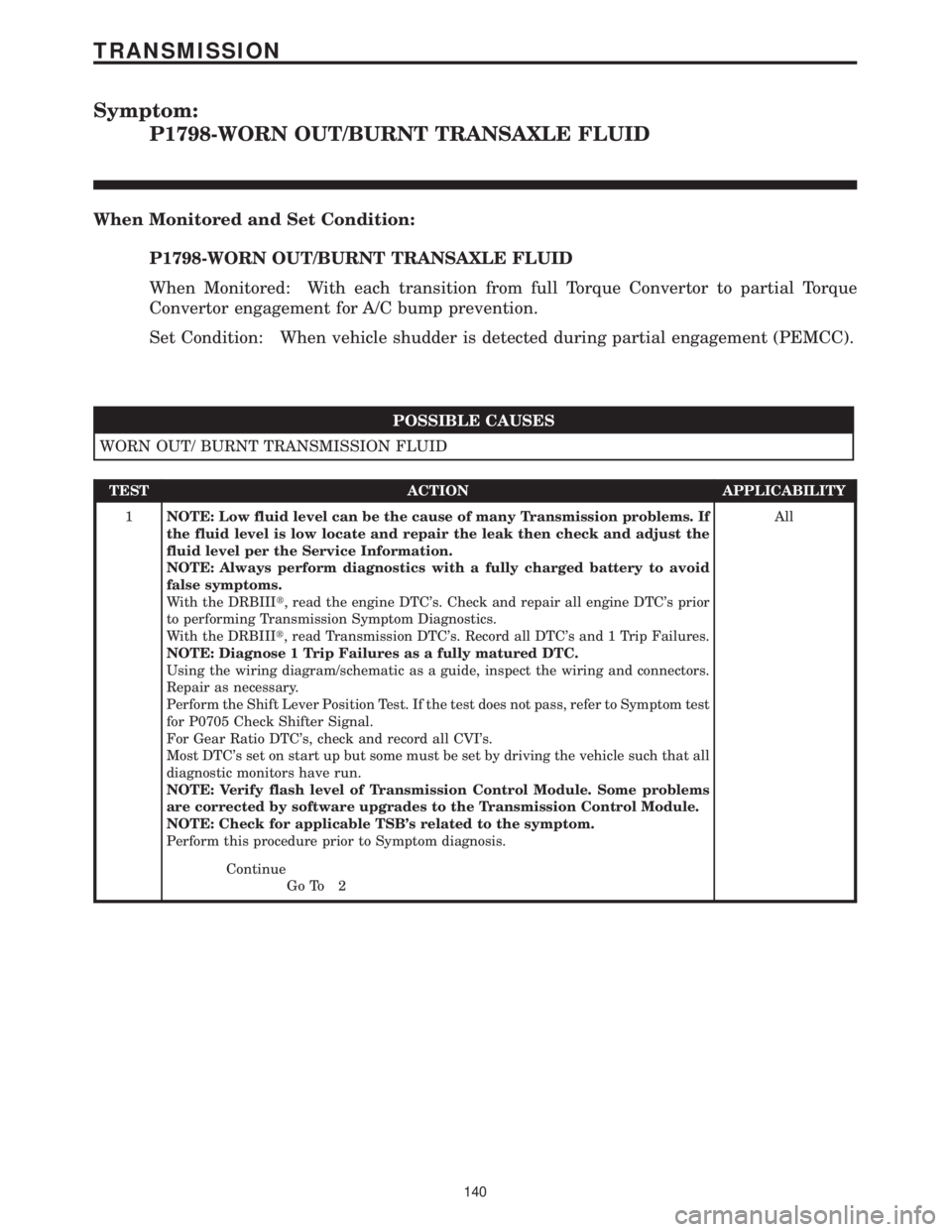
Symptom:
P1798-WORN OUT/BURNT TRANSAXLE FLUID
When Monitored and Set Condition:
P1798-WORN OUT/BURNT TRANSAXLE FLUID
When Monitored: With each transition from full Torque Convertor to partial Torque
Convertor engagement for A/C bump prevention.
Set Condition: When vehicle shudder is detected during partial engagement (PEMCC).
POSSIBLE CAUSES
WORN OUT/ BURNT TRANSMISSION FLUID
TEST ACTION APPLICABILITY
1NOTE: Low fluid level can be the cause of many Transmission problems. If
the fluid level is low locate and repair the leak then check and adjust the
fluid level per the Service Information.
NOTE: Always perform diagnostics with a fully charged battery to avoid
false symptoms.
With the DRBIIIt, read the engine DTC's. Check and repair all engine DTC's prior
to performing Transmission Symptom Diagnostics.
With the DRBIIIt, read Transmission DTC's. Record all DTC's and 1 Trip Failures.
NOTE: Diagnose 1 Trip Failures as a fully matured DTC.
Using the wiring diagram/schematic as a guide, inspect the wiring and connectors.
Repair as necessary.
Perform the Shift Lever Position Test. If the test does not pass, refer to Symptom test
for P0705 Check Shifter Signal.
For Gear Ratio DTC's, check and record all CVI's.
Most DTC's set on start up but some must be set by driving the vehicle such that all
diagnostic monitors have run.
NOTE: Verify flash level of Transmission Control Module. Some problems
are corrected by software upgrades to the Transmission Control Module.
NOTE: Check for applicable TSB's related to the symptom.
Perform this procedure prior to Symptom diagnosis.All
Continue
Go To 2
140
TRANSMISSION